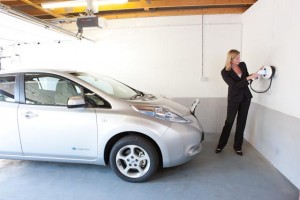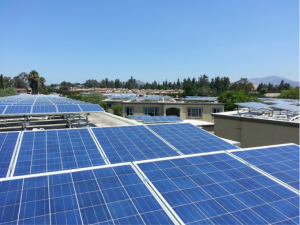California regulators have been busy approving “pilot” projects for utilities to start paying for EV charging infrastructure, at significant ratepayer expense. Last week, they approved PG&E’s controversial plan, which had the blessing of environmentalists and unions, while ratepayer advocates and the San Francisco Chronicle cried foul. It will target a deployment of 7,500 level 2 charging ports and 100 DC fast-charging ports.
And with the passage of SB 350 last year, utilities will be entering the EV charging game big time in the coming years. These pilots are just the initial salvo.
But the state had already required $100 million in EV charging investment from NRG/eVgo as part of a legal settlement in 2012. That company has been badly behind schedule on getting these stations up and running, leading regulators to call for an audit over a year ago.
The status of the audit? Well, I emailed the California Public Utilities Commission recently to find out, and they told me they just hired an auditor to do this work at the end of February. No explanation was offered as to why that took the agency a whole year to do so.
So while regulators are busy ushering utilities into the EV charging world, they’re asleep at the wheel monitoring the state’s $100 million investment already in the works. Not a good sign as utilities start spending big ratepayer bucks on EV charging.
 I’ve been an advocate for letting electric utilities build electric vehicle charging stations for a while now. While nobody likes the ideas of regulated monopolies taking over a market, the fact is that private companies are not getting the job done, and there aren’t sufficient charging stations to meet growing demand and to enable longer-distance electric travel.
I’ve been an advocate for letting electric utilities build electric vehicle charging stations for a while now. While nobody likes the ideas of regulated monopolies taking over a market, the fact is that private companies are not getting the job done, and there aren’t sufficient charging stations to meet growing demand and to enable longer-distance electric travel.
So I’ve been following with interest Pacific Gas & Electric’s (PG&E) proposal to serve the 65,000 EV drivers in its Northern California service territory with 25,100 charging stations (the number that may be necessary to meet Governor Brown’s goal of having one million EVs on the road by 2020).
But the California Public Utilities Commission would like to go slower than that, as Charged EVs reports:
[T]he state Public Utilities Commission has put a stop to PG&E’s dreams of empire for the moment, saying that it will need to hold a series of hearings before authorizing the program.
“We must consider the requirement to protect against unfair competition and the demonstrated costs and benefits of any utility electric vehicle charging station proposal,” PUC Commissioner Carla Peterman wrote in her ruling (via San Jose Mercury News). “We find that a more measured approach to utility ownership in PG&E’s service territory is warranted.”
One objection to PG&E’s plan is the cost: $654 million, which the utility plans to pass on to ratepayers. Under the original PG&E proposal, residential electricity customers would pay an additional 70 cents per month on their utility bills from 2018 to 2022.
Peterman also pointed out concerns that control of such a comprehensive network could give PG&E something of a monopoly. The utility’s plan calls for it to have control over the design and support of the charging facilities, something that other companies in the charging industry say could suppress innovation.
I think this approach could make sense. It may be best to go slow on the roll out to see how the market reacts. The CPUC could also ensure that the initial utility stations are located where there is no strong market incentive for private companies to site them. Ideally the state could end up with a hybrid system of some utility-owned stations and some private company-owned ones. The other possibility is that PG&E provides some of the underlying infrastructure for the stations, while charging companies then compete to set up chargers in those locations.
Either way, I imagine this is only the first step on a path to more utility-owned charging stations, and the result will hopefully be better coverage and convenience for EV drivers.
 Over at the California Public Utilities Commission (CPUC), regulators are having a tough time fending off utility efforts to severely curtail rooftop solar. Legislation passed in 2013 requires the CPUC to engage in a new rate-making process, which has already resulted in rates that eliminate the expensive top tiers that encouraged high-consuming ratepayers to go solar.
Over at the California Public Utilities Commission (CPUC), regulators are having a tough time fending off utility efforts to severely curtail rooftop solar. Legislation passed in 2013 requires the CPUC to engage in a new rate-making process, which has already resulted in rates that eliminate the expensive top tiers that encouraged high-consuming ratepayers to go solar.
But now, according to Greentech Media, new utility proposals promise to limit customer incentives to go solar even more:
PG&E and SCE…want to pay [solar] net-metered customers quite a bit less for the power they feed back to the grid, by paying a rate based on the cost of generating power. That’s similar to a proposal floated by Hawaiian Electric earlier this year.
But these reduced rates don’t take into account the value that net-metered solar provides, [Sunun’s Robert] Harris said. That could come from reduced transmission and distribution grid costs, or replacing the power that would otherwise need to come from new natural-gas-fired power plants.
PG&E noted that a typical solar customer would see a relatively small reduction in monthly bill savings, from 60 percent under today’s rules to about 50 percent under its proposal. But for companies like SolarCity and Sunrun, small reductions multiplied across tens of thousands of customers can add up to big financial impacts.
Even more problematic are the new charges the utilities want to impose on net-metered customers, Harris said. Specifically, PG&E has proposed a $3 per kilowatt-per-month demand charge, based on the one moment during each month that a customer’s energy use reaches its highest peak, while SCE has proposed a $3 per kilowatt-per-month “grid access charge” based on the size of the solar system being connected to the grid.
Severin Borenstein at UC Berkeley’s Energy Institute puts in all into perspective:
Economists have for years argued that utility rate design should follow cost causation principles, because departures from cost will lead to inefficient customer response. Regulators have often paid little heed largely because the inefficiency was small when customer ability to respond was limited. That left regulators a free hand to harness rates for pursuit of other policy agendas.
Distributed generation, storage, electric vehicle charging, and smart customer-side usage technologies (think controllable communicating thermostats) mean that the inefficiencies from sloppy rate design – prices that depart substantially from cost – will be magnified.
But the flip side is that the opportunity to incent efficient customer-side participation in the market with smart rate design is greater than ever. And that opportunity will grow exponentially in the next few years as we see continued improvement in generation technologies, batteries, and sensors that can control a panoply of household activities. Accurate cost-based pricing can not only lower costs, but can also use customer-side participation to gain the flexibility that will be required to integrate more wind and solar power.
If we follow Borenstein’s logic, what the CPUC should really do is set flexible, dynamic rates that reflect that actual cost of providing electricity, and then communicate those price changes to ratepayers instantly, particularly via wired, networked appliances that can adjust demand based on price.
And if the cost figures take into account impacts like pollution from fossil fuel-based power, that could provide a big boost to clean technologies, while protecting ratepayers from inefficient rates.
 Well, it could have been worse. Had the new rates that the California Public Utilities Commission adopted this month imposed a fixed fee on solar customers, it would have killed the solar leasing industry. But instead, the CPUC made rooftop solar a bit less attractive:
Well, it could have been worse. Had the new rates that the California Public Utilities Commission adopted this month imposed a fixed fee on solar customers, it would have killed the solar leasing industry. But instead, the CPUC made rooftop solar a bit less attractive:
In a unanimous vote, the California Public Utilities Commission on Friday approved a proposed decision (PDF) that will flatten out the state’s existing four-tier rate structure to two tiers, with a 25 percent difference in cost between the two.
That move, part of a proposal released in April, has been opposed by solar companies and environmental groups, since it will reduce financial incentives for the state’s highest-electricity-using households to invest in rooftop solar and energy efficiency. The existing four-tier structure was set in place after the state’s 2001 energy crisis, and has gradually grown to a difference of about 13 cents per kilowatt-hour for the lowest tier to as high as 42 cents per kilowatt-hour for the highest tier.
The good news is that the new rates encourage utilities to adopt better time-of-use plans, which could encourage solar customers to buy batteries to dispatch their solar electricity at peak times and get paid more for it. And the rates do have a surcharge for “energy hogs.” But it won’t replace the steep Tier 3 and 4 rates that encouraged so many to go solar. Hopefully future declining costs of the panels will now make up for the longer payback periods that these new rates will create for solar customers.


